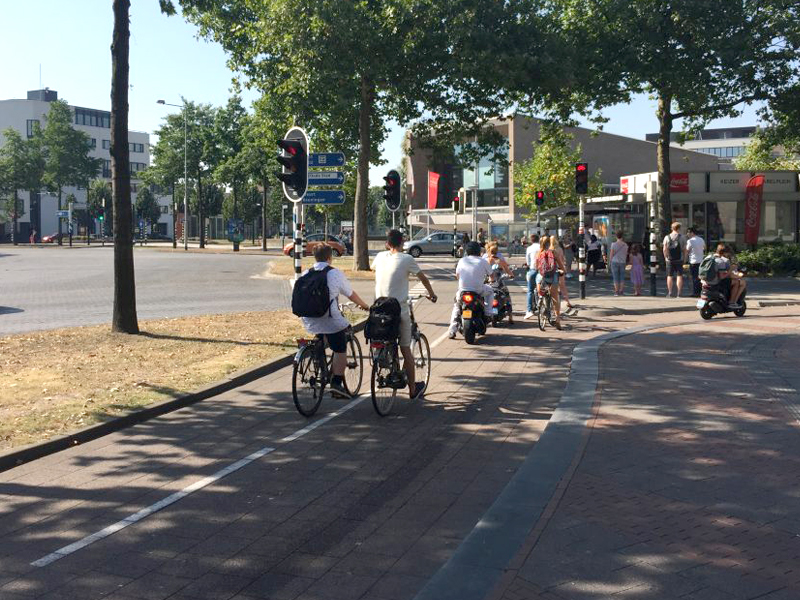Bike Lanes

My first sight when stepping foot in the Netherlands during a recent Comfort Talk training visit: People are slim, fit and seem to peddle as a nation. Bicycles are everywhere, massively stacked at train stations, office buildings, parking garages, and traffic cross points. People ride them everywhere. Bike lanes are spacious, clearly separated from the traffic by green strips or other barriers to protect the riders from cars. They are offset from pedestrian walkways by color (red) and sometimes additional curbs. Nobody wears a helmet. People go about their lives and business in their regular clothes. It looks safe and it is safe.
Bike lanes have their own traffic lights and are integrated in the overall flow – thus no getting cut-off from turning vehicles and not getting swiped off by an opening car door. One doesn’t have to be concerned for one’s life as when riding a bike on Commonwealth Avenue in Boston, where bike lanes wedged between parked cars and aggressive traffic.
When visiting Radboud University Medical Center it dawned on me. There was a floor dedicated to bicycles – thousands of them arranged in tightly stacked two-level contraptions. If the thousands of people who had their bikes parked there would come by car instead the hospital would have had to build another gigantic high garage. Beside, that many more cars would add to traffic congestion for all.
One may extrapolate the concept to the many businesses or schools in a town. Then the argument that providing safe bike lanes is too expensive becomes suddenly untenable and the cost of NOT having them is staggering. It would be cheaper for cities, hospitals and big organizations to have the infrastructure of safe bike lanes as compared to using expensive real estate and constructions for urban parking and maintain it.
My colleagues told me that their kids ride their bikes to school – about 10 miles each way. Consider all the parents who drive their kids to and from school, social activities, and sports. How much better could parents organize time and spare nerves by not having to be the chauffeur? The kids wouldn’t spend as much time on social media while peddling, and getting fit would be an extra bonus point. And did I mention the endorphins that the exercise provides? That more cheerfulness when they are at home!
The bike also changes the social fabric and ability to interact for young people. I often saw groups meeting and getting together in parks or at the river front with their bikes. To do this by car would be too complex: parents aren’t available to drive their kids around, and even the teenagers with a car would find it time consuming to drive to these locations through traffic, find and pay for parking, or use public transportation.
Now let’s say you add twice daily 15 to 45 min bicycling to your daily routine instead of being struck in traffic. The health benefits would be considerable: less obesity, less diabetes, less cardiovascular disease, less depression. Looking fit and having one’s clothes fit probably also might elevate mood. Dutch people then eat well and enjoy their food–without counting every calorie, fat molecule, or carbohydrate. With population health improved, the financial health of the healthcare system also improves, allowing everyone to be insured for excellent care.
If you build them, would they come? Even in the Netherlands with exquisite bike lanes and an equally effective public transportation system there is a push and a pull to get people out of their cars. Gasoline is expensive at about $6.50 per gallon. Cars are taxed heavily based on weight and luxury level, hence you will see many small fuel-economical cars. Parking a bike is free, parking a car expensive. The human psyche is tickled by simple means: the bicycle parking lot is at a choice spot, at the hospital main entrance where most people enter to work. If you park a car you will have to walk further. Parking is not deducted monthly, but at each visit making it a more noticeable expense. If you live more than 15 miles away it is Euro 1.50, if you live in town and drive it is Euro 5 per day.
I recall my German days of cycling to school, work, and shopping. Bikes were there for transportation or leisure – one doesn’t need a speedo suit, helmet, and shower after every trip. Normal clothes do just fine and the hair doesn’t get messed up. After a trip to the Netherlands prior to this this last one, I had my old Raleigh restored. There is just an extra sense of freedom when riding a bike. You may say that is all fine and good, but what to do when it rains? In Europe the solution is easy. If you have a bike with a back-peddling break hub (typical for cruising bikes) you got it made. With a little practice, you can hold an umbrella in one hand and brake with one hand and your feet.
Thinking of the amount of money, nerves, times, suffering and bad mood that could be spared by having safe bike lanes – it is really not affordable NOT to have them.
